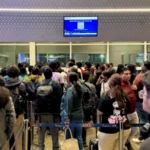Lahore’s air quality is expected to deteriorate further on Tuesday as heavy smog from India’s capital, Delhi, begins to drift across the border, raising serious environmental and health concerns for residents of Pakistan’s cultural hub.
According to data released by Swiss air monitoring company IQAir, Delhi’s Air Quality Index (AQI) soared to a hazardous level of 535 around 8:40 a.m. on Monday. This extreme level of pollution has triggered warnings in both countries, as wind patterns push toxic air toward Pakistan’s Punjab province.
Early signs of smog have already begun to blanket parts of Punjab, prompting authorities to step up preventive measures. In response to the worsening situation, officials have initiated a series of modern anti-smog strategies, restricted certain outdoor activities, and formed a special committee to monitor and manage the crisis.
Lahore, the capital of Punjab and only about 25 kilometers (16 miles) from the Indian border, is once again facing the brunt of transboundary pollution. The city, known for its rich cultural heritage, is now battling one of the most severe air quality challenges in the region.
On Monday, Lahore recorded an AQI of 266, a level classified as “very unhealthy,” making it the second most polluted city in the world. Environmental experts predict that the city’s average AQI could rise further on Tuesday, possibly ranging between 210 and 240, depending on weather conditions and wind flow from Delhi.
The main pollutant driving Lahore’s poor air quality is PM2.5, fine particulate matter that measures 2.5 micrometers or smaller in diameter. These microscopic particles can penetrate deep into the lungs and enter the bloodstream, posing serious risks to heart and respiratory health. IQAir’s data showed that Lahore’s PM2.5 concentration reached 187 µg/m³, which is 37.4 times higher than the World Health Organization’s recommended annual safety limit.
Health professionals have urged citizens to minimize outdoor exposure, wear protective masks, and use air purifiers when possible. Schools and offices have been advised to limit outdoor activities, especially during early morning and evening hours when smog density peaks.
Authorities continue to explore long-term solutions to combat recurring smog in Lahore and other cities across Punjab. The government’s environmental panel is expected to review emission controls, promote cleaner energy options, and strengthen cross-border cooperation to tackle shared air pollution challenges.
As Lahore braces for worsening air conditions, experts emphasize that both short-term protective measures and long-term regional collaboration are essential to safeguard public health and prevent future environmental crises.







